Abstract
In this study, Cr2O3, Cr2O3-SiO2-TiO2 and Cr2O3-SiO2-TiO2-graphite coatings were formed by atmospheric plasma spraying. The influence of SiO2-TiO2 and SiO2-TiO2-graphite reinforcements on the surface morphology, elemental composition, structure and tribological properties of chromia coatings was determined. The friction coefficients and specific wear rates were investigated by a ball-on-flat configuration using 1 N and 3 N loads under dry-lubrication conditions. The addition of SiO2-TiO2-graphite resulted in the lowest surface roughness and the most homogenous surface of the coatings. The X-ray diffraction (XRD) measurements demonstrated that all as-sprayed coatings consisted of an eskolaite chromium oxide phase. The results showed that the Cr2O3-SiO2-TiO2 coating demonstrated the lowest friction coefficient values. The SiO2-TiO2 and SiO2-TiO2-graphite additives reduced the specific wear rates of Cr2O3 coatings by 30% and 45%, respectively. Additionally, the wear resistance was improved almost 45 times in comparison to the steel substrate.
1. Introduction
Cr2O3 coatings are widely used in various fields in order to reduce the wear of metallic parts and metallic surfaces from corrosion [1,2,3,4,5,6].
Plasma spraying is one of the commonly used techniques to deposit ceramic coatings, such as aluminum oxide, chromium oxide, titanium oxide, zirconium oxide, etc., on metallic surfaces [2,4,7,8,9,10]. The mechanical, tribological, thermal or corrosion properties of sprayed Cr2O3 coatings are easily controlled by changing the spraying conditions such as spraying distance, arc current, gas type, gas flow ratio, etc. [2,8,11,12]. Kiilakoski et al. [8] indicated that the surface roughness, hardness, porosity and wear resistance of chromia coatings could be controlled by changing the spray distance, flow rate of air or suspension feed rate.
Another way to improve the hardness and toughness, reduce the friction coefficient, or enhance the wear and corrosion resistance of chromia coatings is to use additive materials. It was demonstrated that TiO2, Al2O3, YSZ-SiC or CeO2 is used to improve the properties of Cr2O3 coatings [2,13,14,15,16,17,18]. Li et al. [14] demonstrated that the addition of TiO2 up to 32 wt.% will improve the tribological properties under dry friction and oil friction conditions. However, it was found that the friction coefficient of Cr2O3-TiO2 coatings in most cases was enhanced from 0.60 up to 0.92 under dry sliding. Our previous investigations [15] indicated that the friction coefficient was reduced, and the specific wear rate decreased from 2.69 × 10−6 mm3/(Nm) to 1.54 × 10−6 mm3/(Nm) after doping of chromium oxide coating with SiO2-TiO2. Mao et al. [16] observed that the wear rate of the chromium oxide coating was 14.6 × 10−7 mm3/(Nm) and, depending on the alumina fraction, varied from 8.2 to 12.9 × 10−7 mm3/(Nm) for Cr2O3-Al2O3 coatings. However, the friction coefficient values under dry-sliding conditions for Cr2O3 and Cr2O3-Al2O3 coatings remained similar. Bolelli et al. [17] demonstrated that the friction coefficients and wear rates were enhanced with the addition of TiO2, Al2O3 or ZrO2 into Cr2O3 coatings. Singh et al. [19] showed that the friction coefficient of conventional and nanostructured Cr2O3-3%TiO2 coatings varied between 0.55 and 0.80 depending on the applied loads and sliding distances. Ding et al. [20] showed that the properties of Cr2O3-20wt.% TiO2 coatings could be improved with the addition of CeO2. It was obtained that the surface roughness and the porosity were reduced, the bonding strength was enhanced and the friction coefficient was reduced from 0.68 to 0.62 with the addition of CeO2 into Cr2O3-TiO2 coatings. Hashemi et al. [21] obtained that Cr2O3-YSZ and Cr2O3-YSZ-SiC coatings demonstrated higher porosity, lower bonding strength and slightly higher friction coefficient values, but the wear rate of the coatings was reduced up to three times compared to the Cr2O3 coating.
The tribological properties of plasma-sprayed ceramic coatings could be improved with the addition of solid lubricant materials such as graphene nanoplatelets [22,23], carbon nanotubes [24], graphene oxide [25] or graphite [26,27]. It was demonstrated that graphene oxide improved the fracture toughness and reduced the microhardness of alumina-graphene oxide-sprayed coatings [25]. The addition of both carbon nanotubes (CNTs) and graphite nanoparticles (GNPs) increased the hardness, elastic modulus and fracture toughness of alumina coatings [23]. Venturi et al. [22] observed that the wear rate was reduced by ~20%, while the friction coefficient decreased from 0.60 to 0.51 with the incorporation of graphene nanoplatelets into Cr2O3 coatings. Bagde et al. [27] indicated that the addition of Ni-graphite into the Cr2O3-TiO2 coating decreased the friction coefficient values, while the abrasive wear resistance was enhanced from 1.3 up to 2 times depending on the used loads. Goyal et al. [24] showed that the reinforcement of chromia coatings with carbon nanotubes drastically reduced corrosion rates. The performed studies demonstrated that the incorporation of TiO2 improves the mechanical and tribological properties of the Cr2O3 coatings, but the properties of the coatings are greatly influenced by the concentration of TiO2, type of used powder and spraying conditions [13,14,15,17,19]. Another effective way to improve the tribological properties of ceramic coatings is to introduce carbon-based materials (graphite, graphene, graphene oxide, etc.) into the ceramic matrix [22,23,24,25,26,27]. It should be noted that studies on the incorporation of carbon-based materials into chromia coatings are very scarce in the scientific literature. In addition, the effect of graphite on the tribological behavior of chromium oxide composite coatings formed by atmospheric plasma spraying using air-hydrogen plasma was not studied previously.
The main aim was to investigate the effect of the addition of SiO2-TiO2 and SiO2-TiO2-graphite on the surface morphology, phase structure, elemental composition and tribological properties under the dry sliding of chromium oxide composite coatings deposited by atmospheric plasma spraying.
2. Experimental Section
The plasma torch used for the formation of the coatings was developed at the Lithuanian Energy Institute [28]. The P265GH steel was used as a substrate to deposit the chromium (Cr2O3) and chromium composite (Cr2O3-SiO2-TiO2 and Cr2O3-SiO2-TiO2-graphite) coatings. The dimensions of the P265GH steel were: length, 40 mm; width, 10 mm; and thickness, 6 mm. The steel was located on a holder that was cooled by water. The deposition of the coatings was performed using atmospheric pressure air plasma spraying, and the parameters of the process were: arc current, 200 A; total gas flow rate, 3.7 g/s; hydrogen gas, which was used to enhance the degree of melting of the powder particles, 0.053 g/s. Such parameters resulted in ~41.0 kW of torch power and an average temperature of the plasma at the torch nozzle chamber (at the point of powder injection) of 3780 ± 50 K. The average plasma temperature at the torch nozzle exit was 3480 ± 30 K. Coatings were formed as the powders were injected into the plasma by a powder carrier gas (air) at a flow rate of 0.48 g/s. The distance between the plasma torch nozzle outlet and the coating surface was 70 mm, and the spraying duration was 40 s. The MOGUL PC 18 powder (MOGUL METALLIZING GmbH, Kottinbrunn, Austria) of Cr2O3 (purity, 99.7%; and mesh size, 45 + 22 μm) was used to deposit the chromium oxide coatings. Meanwhile, the Cr2O3 composite coatings were sprayed using Cr2O3-SiO2-TiO2 (92/5/3, MOGUL PC 17, mesh size: 45 + 22 m, MOGUL METALLIZING GmbH, Kottinbrunn, Austria) powders, in which SiO2 and TiO2 were mixed in 5% and 3% by weight, respectively [15]. Graphite powders of nonregular shape (MOLYDUVAL Fondra NS, particle size: <25 μm) were also used [29]. The graphite was mixed into the Cr2O3-SiO2-TiO2 at the weight ratio of 10% to produce Cr2O3-SiO2-TiO2-graphite feedstock powders. The powders were mechanically mixed for 24 hours. All feedstock powders were dried at ~350 K for at least 18 hours before the plasma spraying. For better adhesion between the coating and the substrate, Al as a bonding layer was deposited.
The top-view morphology of the deposited coatings was investigated by scanning electron microscopy (SEM) (Hitachi S-3400N (Hitachi, Tokyo, Japan)), and the elemental composition was measured using energy-dispersive X-ray spectroscopy (EDS) with a Bruker Quad 5040 spectrometer (AXS Microanalysis GmbH, Billerica, MA, USA). The measurement data were collected and measured from at least five different surface locations with a surface area magnification of x100. Linear surface roughness was measured using a Mitutoyo Surftest SJ-210 Series tester (version 2.00 with standard ISO 1997 Mitutoyo, Kawasaki, Japan). The roughness values given are the average of at least 15 separate measurements. The length of one track was 4 mm, the speed of the measurement was 0.50 mm/s, the detector measuring force was 0.75 mN and a diamond tip was used. The calculation of average roughness values (Ra, Rq) was performed by a roughness tester according to the ISO4287:1997 standard. Cut-off λc was equal to 0.8 mm. The surface roughness of all coatings was measured at the same conditions.
The phase analysis was carried out by the X-ray diffraction technique (XRD) using the D8 Discover apparatus (Bruker D8 Discover, Billerica, MA, USA) with a CuKα (λ = 0.154059 nm) cathode. The XRD patterns were recorded under standard Bragg–Brentano configuration in the range of 2θ from 10° to 80°. The diffraction patterns of the coatings were analyzed by DIFFRAC.EVA software. The tribological properties were determined using a CETR-UMT-2 tribometer (CETR, Campbell, CA, USA) and ball-on-flat configuration with 1 N and 3 N loads under dry-sliding conditions. The duration of the tribological tests was 120 min, the sliding speed was 0.1 m/s, and the total covered distance was 720 m. A 10 mm diameter Al2O3 ball (grade class 10 and 99.5%) was used as a counterpart, and the stroke length was 5 mm. The specific wear rate was calculated from the linear surface profiles that were obtained with Ambios XP-200 Profiler (Ambios Technology Inc., Santa Cruz, CA, USA). Tribological tests of Cr2O3 and chromia composite coatings were performed on two samples of each series, and average values (of at least four measurements) were determined.
3. Results and Discussion
The as-sprayed chromia and chromia composite coatings’ surface morphology is shown in Figure 1. It was obtained that the deposited coatings consisted of melted particle regions with partially melted particles. It should be noted that the amount of fully melted particle regions in the Cr2O3-SiO2-TiO2 coating was slightly higher compared to the Cr2O3 coating (Figure 1b,d). Mostly, the surface of the Cr2O3-SiO2-TiO2-graphite coating was even and homogenous (Figure 1e,f). All deposited coatings had a grain structure with a low amount of microcracks and pores (Figure 1). The existence of the microcracks is a result of the rapid solidification of partly or fully melted particles on the substrate [19]. The existence of various-shaped microsized particles on the surface when the particles hit the substrate could be related to the splashing of partly molten feedstock particles. The porosity of deposited coatings is related to the existence of coarse and fine pores. It was demonstrated that the coarse porosity in the plasma-sprayed coatings is attributed to structural defects. These defects were created by the incomplete filling of the voids between impacting powder particles to the surface [14,19]. SEM images of surface morphology demonstrated that the addition of TiO2 and SiO2 into Cr2O3 powders resulted in the formation of a slightly lower amount of larger-sized voids on the surface.
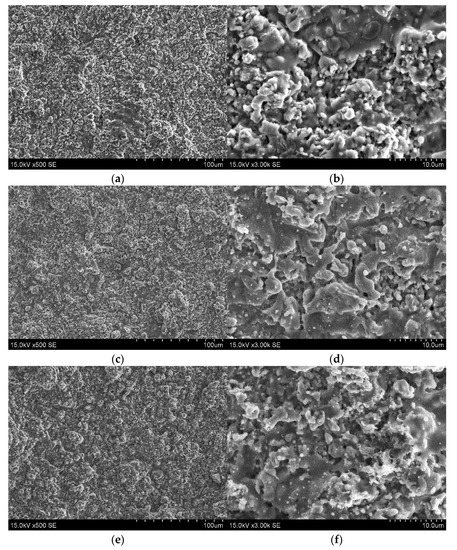
Figure 1.
Surface morphology of (a,b) Cr2O3, (c,d) Cr2O3-SiO2-TiO2 and (e,f) Cr2O3-SiO2-TiO2-graphite coatings.
The distribution of chromium, oxygen, titanium, silicon and carbon on the Cr2O3-SiO2-TiO2 and Cr2O3-SiO2-TiO2-graphite coatings is presented in Figure 2 and Figure 3. The EDS results showed that the distribution of chromium, oxygen and titanium on the surface of the Cr2O3-SiO2-TiO2 and Cr2O3-SiO2-TiO2-graphite coatings is homogenous. The EDS map image (Figure 3f) indicated that the graphite particles were quite homogeneously spread on the surface of the as-sprayed coating. In addition, single graphite particles with a size of up to 40 µm could be observed on the surface. It should be noted that silicon tends to agglomerate and form larger clusters on the surface of the chromia composite coatings (Figure 2f and Figure 3e). The existence of larger-sized SiO2 inclusions is due to the fact that the SiO2 particles were not homogenously distributed in the raw powders and/or were agglomerated into bigger-sized clusters during manufacturing. The Cr2O3-SiO2-TiO2 coating was composed of chromium (∼73.6 wt.%), oxygen (22.2 wt.%), titanium (3.3 wt.%) and silicon (∼0.8 wt.%), and a low amount of carbon was obtained due to the absorption of atmospheric air. The as-sprayed coating consisted of Cr (∼73.7 wt.%), O (∼21.4 wt.%), Ti (3.0 wt.%), Si (0.8 wt.%) and carbon (∼1.1 wt.%) when 10 wt.% of graphite was added to the initial Cr2O3-SiO2-TiO2 powders. The EDS measurements showed that the graphite content on the surface was up to 10 times lower compared to the feedstock powders. The chromia coating is composed of chromium (78.3 wt.%) and oxygen (21.3 wt.%), and a low amount of impurities (carbon and aluminum) was detected.
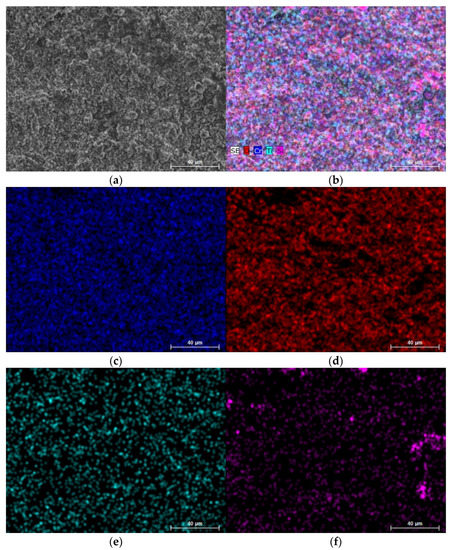
Figure 2.
SEM micrograph (a) and elemental maps of Cr2O3-SiO2-TiO2 coating: (b) all elements. (c) chromium, (d) oxygen, (e) titanium and (f) silicon at 500 magnifications.
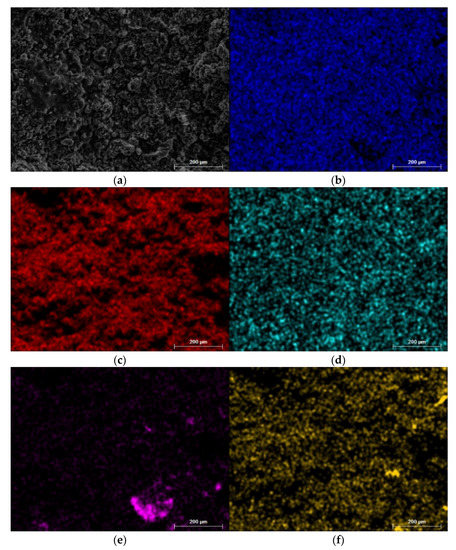
Figure 3.
SEM surface image (a) and elemental maps of Cr2O3-SiO2-TiO2-graphite coating: (b) chromium, (c) oxygen, (d) titanium, (e) silicon and (f) carbon at 100 magnifications.
The surface roughness of the as-sprayed coatings is presented in Figure 4. The average surface roughness (Ra) and the root-mean-square roughness (Rq) of the Cr2O3 coating were ∼3.02 ± 0.51 μm and ∼3.77 ± 0.61 μm, respectively. The surface roughness of the Cr2O3-SiO2-TiO2 coating was slightly, up to ~20%, higher. The Ra value was 3.85 μm, while the Rq value was 4.86 μm. Meanwhile, the roughness of the coating was drastically reduced (by 40%) when 10 wt.% of graphite was added to the Cr2O3-SiO2-TiO2 powders. The surface roughness Ra and Rq values for the Cr2O3-SiO2-TiO2-graphite coating were 2.22 μm and 2.77 μm, respectively. The reduction of surface roughness of the Cr2O3-SiO2-TiO2-graphite coating in comparison to the Cr2O3-SiO2-TiO2 coating could be related to the lower size and density of the graphite powders. If we compare the volume of both powders, there were almost equal parts of them in the feedstock mixture.
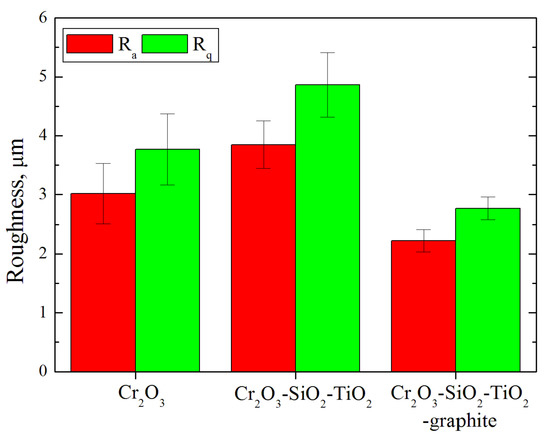
Figure 4.
Surface roughness of as-sprayed coatings.
It was demonstrated that the addition of graphite nanoparticles (GNPs) or GNPs and carbon nanotubes (CNTs) into alumina reduced the surface roughness (up to 13%) of the as-sprayed alumina composite coatings [29]. Wang et al. [30] obtained that the addition of 3% or 6% of graphene into Al2O3-TiO2 coatings reduced the porosity of the coatings. In addition, the surface of the coatings becomes flatter and denser after the addition of graphene. Similar results were found for the Cr2O3-SiO2-TiO2 coating with the addition of graphite into feedstock powders. The surface images of the Cr2O3-SiO2-TiO2 coating demonstrated that the amount of fully molten regions was higher compared to the Cr2O3 coating. However, the surface roughness of the Cr2O3-SiO2-TiO2 coating was enhanced. Zamani et al. [2] also obtained that the surface roughness of the Cr2O3 coating was lower compared to Cr2O3-SiO2-TiO2 coatings. However, the surface roughness was reduced with the increased amount of Al2O3 due to the lower melting temperature. The fraction of splats increases on the surface of deposited chromia or chromia composite coatings with the increase of the plasma jet temperature or supplementation of the metal oxides with lower melting temperature into feedstock powders [11,15,16,31].
The XRD graphs of the Cr2O3 and Cr2O3 composite coatings are given in Figure 5. It should be noted that the patterns of all coatings showed the same peaks, and only the intensities of the peaks are slightly different. The peaks are located at 24.6, 33.7, 36.3, 41.6, 50.3, 55.0, 63.6, 65.3 and 73.1 2θ degrees and are attributed to the (012), (104), (110), (202), (024), (116), (214), (300) and (1010) orientations of the Cr2O3 eskolaite phase, respectively [10,14,15,32]. The low- and broad-intensity peaks located at ~40.0°, ~44.4°, ~58.5°, and ~76.9° are assigned to the (006), (202), (122) and (220) planes of the eskolaite Cr2O3 phase, respectively [14,15,23]. The normalized intensities of the initial powders and as-sprayed coatings are presented in Table 1. It should be noted that the highest-intensity peak for the initial Cr2O3 powders was located at ~55.0°. Meanwhile, the as-sprayed chromia coatings had the highest peak at ~33.7°. The intensity of the peak at ~36.3° was slightly lower. It should be noted that the intensities of dominant peaks of the eskolaite Cr2O3 phase increased in the as-sprayed Cr2O3 coating (Table 1). The highest-intensity peak for the Cr2O3 coating was related to the (104) orientation (Figure 5). The addition of SiO2-TiO2 into the Cr2O3 coatings resulted in the intensity of the peak presented at ~33.7° (104) being slightly lower compared to the peak located at ~36.3° (110). The intensities of peaks for the Cr2O3-SiO2-TiO2-graphite and Cr2O3-SiO2-TiO2 coatings were similar (Figure 5). The highest-intensity peak in the Cr2O3-SiO2-TiO2 feedstock powders was obtained at ~36.3°. The order of the five highest peaks according to normalized intensity remains unchanged in the as-sprayed Cr2O3-SiO2-TiO2 coating. Only a slight increase or decrease in the peak intensities was obtained (Table 1.). The addition of graphite into Cr2O3-SiO2-TiO2 resulted only in a slight reduction in the intensities of most peaks. However, the intensities of the peaks at ~41.6° and ~63.6° were enhanced for the Cr2O3-SiO2-TiO2-graphite coating.
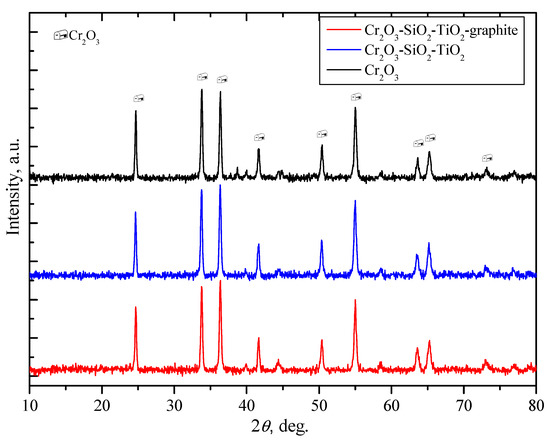
Figure 5.
The XRD patterns of the Cr2O3, Cr2O3, Cr2O3-SiO2-TiO2 and Cr2O3-SiO2-TiO2-graphite coatings.

Table 1.
The normalized intensity values of XRD peaks in the powders and coatings.
The TiO2 or SiO2 phases were not detected in the XRD data of the Cr2O3-SiO2-TiO2 and Cr2O3-SiO2-TiO2-graphite coatings. Usually, the presence of the TiO2 rutile phase in the XRD patterns of thermally sprayed coatings is attributed to peaks located at 27.5, 41.3, 54.4 and 56.7° [10,14,19]. However, it was observed that the TiO2 rutile phase may not be detected in the XRD data of the chromia composite coatings with a low amount of TiO2 (up to 5%) [32]. The crystalline graphite peak (at 26.5°) was not obtained in the XRD pattern of the Cr2O3-SiO2-TiO2-graphite coating [26,33]. Our previous study [26] demonstrated that the low-intensity crystalline graphite peak in alumina–graphite coatings was observed when the graphite content was 1.6 wt.%.
The variation of the friction coefficient curves depending on sliding time is given in Figure 6. Similar behavior of the friction coefficient curves was obtained for all as-sprayed coatings. The average values of the friction coefficient for the Cr2O3, Cr2O3-SiO2-TiO2 and Cr2O3-SiO2-TiO2-graphite coatings using 1 N load were estimated as ~0.369, ~0.316 and ~0.405, respectively (Figure 7a). The friction coefficient of the steel substrate was ~0.687 when 1 N load was used [15]. The friction coefficients of the coatings slightly increased with the enhancement of the applied load (Figure 7a). The lowest friction coefficient was obtained for the Cr2O3-SiO2-TiO2 coating and was ~0.378. Meanwhile, the highest value of the friction coefficient (~0.416) was observed for the Cr2O3-SiO2-TiO2-graphite coating. Thus, the friction coefficient slightly decreased (by 2%) when the SiO2-TiO2 additive was used. Meanwhile, the addition of SiO2-TiO2-graphite fractionally increased (up to 8%) the friction coefficient of the Cr2O3 composite coatings. Despite the fact that the friction coefficient of all the coatings increased with the increase in the applied load, it was significantly lower (up to 40%) than that of the P265GH steel (~0.630).
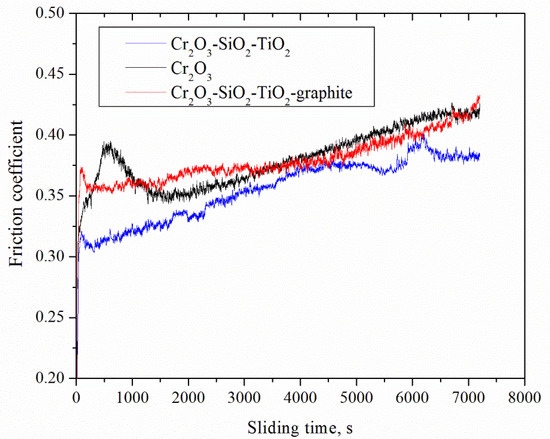
Figure 6.
The variation of friction coefficients of coatings versus sliding time when 3 N load was used.

Figure 7.
Friction coefficients of deposited coatings (a) and the specific wear rates of coatings when 3 N load was applied (b).
It was demonstrated that the addition of a low amount of graphene oxide could reduce the friction coefficient of alumina coatings by 15%. However, the friction coefficient could also be enhanced from 0.49 to 0.52 with the increase in the used load [34]. Priyadershini et al. [29] observed that the addition of a low amount of GNPs and CNTs into alumina coatings resulted in a higher friction coefficient at the initial (up to 300 m) sliding distances. It was obtained that the friction coefficient depends on the applied load, type of used counterpart, porosity, hardness, surface roughness of the material, etc. [11,14,21,34,35]. Liang et al. [35] observed that the average friction coefficient decreased with the increase in the initial roughness values of the material. Riedl et al. [36] determined that the friction coefficient of Al2O3 coating with the alpha phase was slightly reduced after surface polishing. Meanwhile, the friction coefficient of the Al2O3 coating with the kappa phase demonstrated an opposite trend. The steady state of the friction coefficient for the Cr2O3 coating was reached after 1500 s of sliding time, while the steady state for the Cr2O3-SiO2-TiO2-graphite coating was reached after 200–300 s. The surface with a larger initial roughness will need more time to reach the steady friction coefficient values, because the sharp hilltops must be grounded off first [35,36]. In addition, the smoother the surface, the greater the contact area between the friction pair, which can lead to higher friction coefficient values. The slight increase in the friction coefficient versus time for ceramic coatings and ceramic-carbon-based coatings during the steady-state region was observed in several studies when dry-sliding and different loads were used [11,14,30,34].
The average specific wear rates of the deposited coatings using 3 N load are presented in Figure 7b. The wear rate of the chromium oxide coating was ∼1.83 × 10−6 mm3/(Nm). The specific wear rate decreased to ∼1.27 × 10−6 mm3/(Nm) with the addition of SiO2-TiO2 into the chromium oxide powders. The addition of the graphite in the feedstock powders stipulated the formation of the coating with the lowest specific wear rate of ∼0.95 × 10−6 mm3/(Nm). It should be mentioned that the specific wear rates of the P265GH steel were 6.68 × 10−5 mm3/(Nm) and 4.22× 10−5 mm3/(Nm) when 1 N and 3 N loads were used, respectively. The reduction of the wear rate of the chromia composite coatings could be attributed to the enhanced densification, reduction of porosity, presence of transferred layer from the Al2O3 ball and formation of self-lubricating graphite layer (in the case of Cr2O3-SiO2-TiO2-graphite) [29,33]. The increase in the sliding wear rates of the Cr2O3 coatings with the incorporation of TiO2 compared to the Cr2O3 coatings during the sliding tests against an Al2O3 counterpart was noticed by several authors [13,17,19,37,38]. It was obtained that the reinforcement of TiO2 decreased the hardness, and as a result, the resistance to wear of the Cr2O3-TiO2 coatings was reduced [13].
The wear tracks of the chromium oxide and its composite coatings under the loads of 1 N and 3 N are presented in Figure 8. It should be noted that the surface of the as-sprayed coatings was only slightly damaged when 1 N load was applied (Figure 8a,c,e). The randomly distributed worn areas of 10 μm to 30 μm in size could be seen on the surfaces. The surface profile measurements demonstrated similar profiles as for deposited coatings. Thus, it was not possible to calculate the wear rates of the as-sprayed coatings, as only the top hills were fractionally abraded when tribological tests were performed using a load of 1 N. Meanwhile, the specific wear rate of the steel substrate under 1 N load was 6.68 × 10−5 mm3/(Nm). Compared with 1 N, and with the increased load up to 3 N, the interfacial contact area of the coatings increased. The SEM images indicated that the wear scars became wider, brighter and more worn-out areas were observed (Figure 8). These results indicate that the damage level and wear loss increased and resulted in a higher wear rate of the coatings.
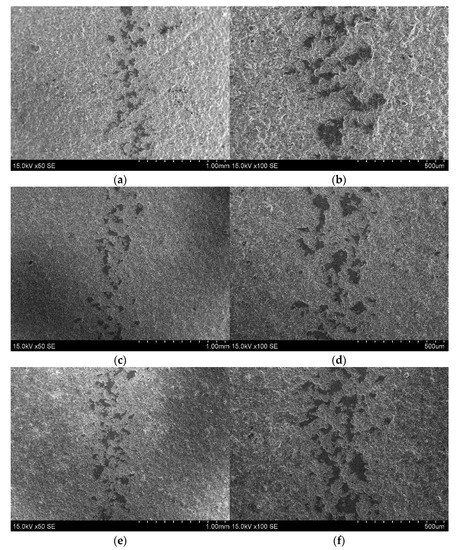
Figure 8.
Wear scars views of (a,b) Cr2O3, (c,d) Cr2O3-SiO2-TiO2 and (e,f) Cr2O3-SiO2-TiO2-graphite coatings after tribological tests with (a,c,e) 1 N and (b,d,f) 3 N loads.
The distribution of chemical elements on the wear scars of the coatings after tribological tests using 3 N load is presented in Figure 9, Figure 10 and Figure 11. A low amount of aluminum from the alumina ball was obtained on the worn scars of all coatings (Figure 9e, Figure 10e and Figure 11e). Additionally, due to the heat generated during the sliding process, the small concentrations of carbon at a contact zone were determined (Figure 9f and Figure 10f). The EDS results showed that the concentration of chromium was ~71.6 wt.%, oxygen ~27.1 wt.%, aluminum 0.9 wt.% and carbon 0.4 wt.% on the wear tracks of the chromia coating after the tribological tests with 3 N load. The amount of Cr was ~67.7 wt.%, O—26.4 wt.%, Ti—3.0 wt.%, Si—1.5 wt.%, C—0.5 wt.% and Al—0.9 wt.% on surface of the Cr2O3–SiO2-TiO2 coating. The concentration of chromium was ~68.7 wt.%, oxygen ~25.4 wt.%, titanium ~2.7 wt.%, silicon ~0.7 wt.%, aluminum 1.1 wt.% and carbon 1.4 wt.% on the wear track of the Cr2O3–SiO2-TiO2-graphite coating. The increase in the oxygen concentration and the reduction of chromium amount on the wear scars for all coatings were observed after the tribological tests. The slight oxidation of chromia ceramic coatings after tribological tests was observed by Amanov et al. [18] and is a result of abrasive wear.
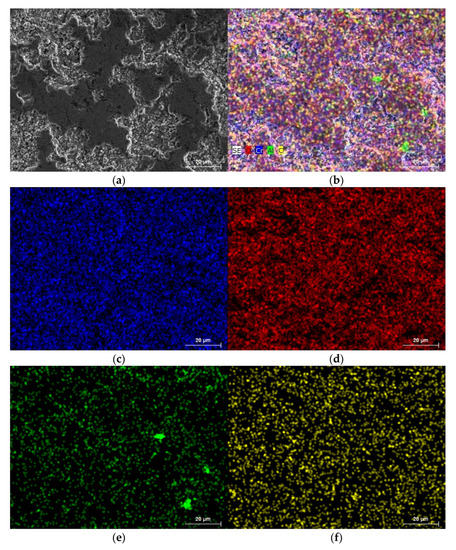
Figure 9.
SEM (a) and EDS mapping images of worn surface of Cr2O3 coating, all detected elements (b),chromium (c), oxygen (d), aluminum (e) and carbon (f) on the wear scar surface of Cr2O3 coating.
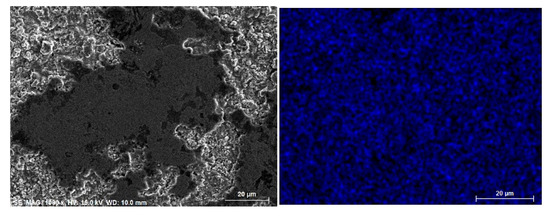
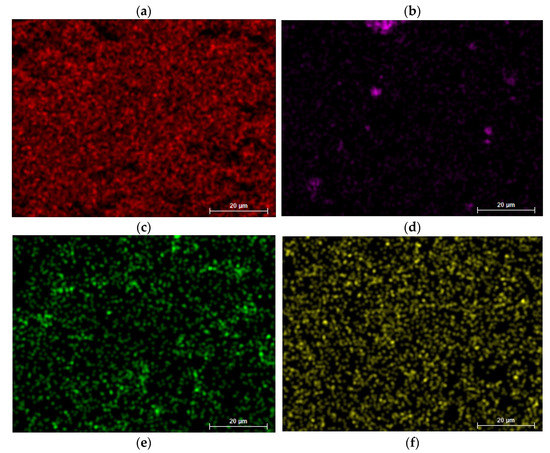
Figure 10.
SEM (a) and EDS mapping images of worn surface of Cr2O3–SiO2-TiO2 coating, Cr (b), O (c), Si (d), Al (e) and C (f).
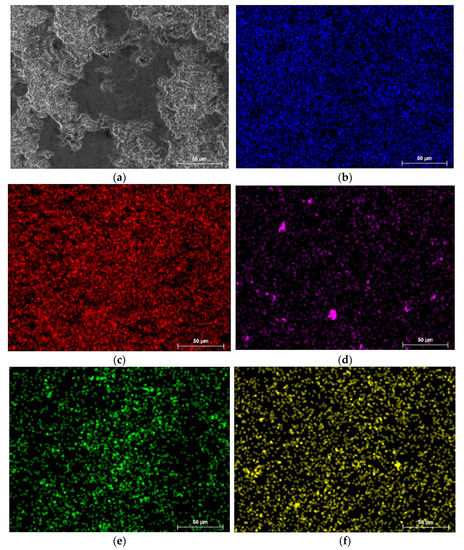
Figure 11.
SEM (a) and EDS mapping images of worn surface of Cr2O3–SiO2-TiO2-graphite coating, Cr (b), O (c), Si (d), Al (e) and C (f) when 3 N load was used.
The EDS results indicated the presence of Al and an increase in carbon elemental concentration in the worn surfaces of the coatings after the tribological tests. A low amount of aluminum was (from 0.9 wt.% to 1.1 wt.%) observed for all coatings after the tribological tests. This confirms the formation of the tribolayer of Al and is a result of the wear between the counterpart (Al2O3 ball) and coating [34]. The existence of carbon indicates the formation of a graphite-base film on the surface of the removed areas [26,33]. The graphite may act as a solid lubricant to prevent the direct contact between the Al2O3 ball and the surface of the coating. The SEM images indicated that the wear scars are noncontinuous (Figure 8). Thus, effective lubrication would be provided only in the direct contact zone. The EDS results and mapping images indicated that the amount of carbon at the wear scar areas increased from ~1.1 to ~1.4 wt.%. Feng et al. [33] demonstrated that the GNPs and graphite particles start to act as a self-lubricant, and a stable tribofilm layer is formed on the surface of the Al2O3-TiO2 coatings when the applied loads are 15 N or higher. Thus, the friction coefficient values would remain similar or even higher compared to the Cr2O3-SiO2-TiO2 coating. In our case, the used 1 N and 3 N loads in tribological tests are considered as light loads. Thus, the wear volume was very low (see Figure 8), and the graphite particles could not be effectively pulled out from the Cr2O3-SiO2-TiO2-graphite coating to act as a self-lubricant.
Wear debris in the form of small microsized particles was obtained on the surfaces of the coatings. The size of the debris was very similar for all coatings. Usually, the interfacial bonding between the formed splat starts to delaminate at higher loads or longer sliding distances. However, the lamellar debris was not produced under used loads. Severe abrasive wear is probably the main wear mechanism during the dry-sliding tests. As for the single one, parallel grooves can be obtained on the wear tracks of the coatings [18,27,39,40]. The particles are extracted from the coating and are crushed in the contact zone between the surface of the coating and the sliding Al2O3 ball. The pulled-out TiO2 or TiO2-graphite particles start to form a lubricative layer and improve the tribological properties (especially wear rate). Meanwhile, the hard Cr2O3 particles act as an abrasive and can tear up the formation of the tribolayer. The traces of Al on the worn surfaces also indicate that the Al2O3 ball slightly rubs and wears and could be involved in the formation of the tribolayer. The increase in the graphite amount on the wear scars is evidence of the initial tribofilm formation. It was reported that the graphite layer led to the reduction of the shear stress level and plastic deformation in the contact zone, which reduces the wear rate of ceramic coatings [27,39].
The tribological investigations demonstrated that the addition of SiO2-TiO2 and SiO2-TiO2-graphite additives had an insignificant effect on the friction coefficient of the chromia coating when 3 N load was used. However, the wear resistance of the chromia composite coatings under dry-sliding conditions was improved by up to ~45% compared to the chromia coating.
4. Conclusions
Cr2O3 and chromia composite coatings were formed by atmospheric plasma spraying. The addition of SiO2-TiO2 enhanced (up to 20%) while the SiO2-TiO2 -graphite additive decreased (25%) the surface roughness compared to the Cr2O3 coating. The addition of graphite increased the homogeneity of the surface and enhanced the amount of molted areas on the surface of the Cr2O3–SiO2-TiO2-graphite coating. The concentration of carbon in the as-sprayed coating was only ~1.1 wt.%, indicating that most of the graphite was lost in the plasma flow due to sublimation. The XRD results indicated that the Cr2O3, Cr2O3–SiO2-TiO2 and Cr2O3–SiO2-TiO2-graphite coatings consisted only of the eskolaite phase. The lowest friction coefficient values of 0.316 and 0.378 were observed for the Cr2O3–SiO2-TiO2 coating when the friction tests were carried out using 1 N and 3 N, respectively. The amount of carbon on the wear scars was ~1.4 wt.%, which is ~25% higher compared to the as-sprayed coating. This indicates the formation of the self-lubricating layer on the surface. However, the applied loads were too low for the formation of the continuous wear tracks, and the effect of graphite as a solid lubricant was limited. The friction coefficient of the coatings was lower by 40% in comparison to the steel under dry-sliding conditions. The wear resistance of the Cr2O3 coatings was enhanced by ~30% and ~45% with the addition of SiO2-TiO2 and SiO2-TiO2-graphite, respectively. The improvement in tribological properties of the Cr2O3 composite coatings could be related to a higher amount of molted particle areas on the surface due to the lower melting temperatures of SiO2 and TiO2. The lowest specific wear rate of 0.95 × 10−6 mm3/(Nm) was reached for the Cr2O3–SiO2-TiO2-graphite coating, which was considerably lower (up to 45 times) compared to the steel value.
Author Contributions
Conceptualization, L.B. and L.M.; methodology, L.B., M.M., R.K. and M.K.; software, L.B.; validation, L.B. and M.M.; formal analysis, L.B. and L.M.; investigation, L.B., L.M., M.M., R.K. and M.K.; data curation, L.B.; writing—original draft preparation, L.B., M.M. and L.M.; writing—review and editing, L.B. and L.M.; visualization, L.B. and L.M.; supervision, L.B.; All authors have read and agreed to the published version of the manuscript.
Funding
This research received no external funding.
Institutional Review Board Statement
Not applicable.
Informed Consent Statement
Not applicable.
Data Availability Statement
Not applicable.
Acknowledgments
The authors thank M. Grigaliūnas from the Kaunas University of Technology and S. Matkovič from the University of Ljubljana for tribological measurements.
Conflicts of Interest
The authors declare no conflict of interest.
References
- Ratia, V.; Zhang, D.; Daure, J.; Shipway, P.; McCartney, D.; Stewart, D. Sliding wear of a self-mated thermally sprayed chromium oxide coating in a simulated PWR water environment. Wear 2019, 426, 1466–1473. [Google Scholar] [CrossRef]
- Zamani, P.; Valefi, Z.; Jafarzadeh, K. Comprehensive study on corrosion protection properties of Al2O3, Cr2O3 and Al2O3–Cr2O3 ceramic coatings deposited by plasma spraying on carbon steel. Ceram. Int. 2021, 48, 1574–1588. [Google Scholar] [CrossRef]
- Lee, D.; Tucker, J.R.C.; Crawmer, D.E.; Karthikeyan, J.; Sanpo, N.; Wang, J.; Berndt, C.C.; Knapp, J.; Lemen, D.; Riggs, W.; et al. Wear-Resistant Coatings. ASM Int. 2013, 5, 253–256. [Google Scholar] [CrossRef]
- Heimann, R.B. Plasma Spray Coating Principles and Applications; Wiley-VCH: Weinheim, Germany, 2008. [Google Scholar]
- Fauchais, M.B.P.L.; Heberlein, J.V.R. Thermal Spray Fundamentals. In From Powder to Part; Springer: Greer, SC, USA, 2014. [Google Scholar]
- Babu, P.S.; Sen, D.; Jyothirmayi, A.; Krishna, L.R.; Rao, D.S. Influence of microstructure on the wear and corrosion behavior of detonation sprayed Cr2O3-Al2O3 and plasma sprayed Cr2O3 coatings. Ceram. Int. 2018, 44, 2351–2357. [Google Scholar] [CrossRef]
- Rao, K.S.; Girisha, K.; Shree, R.P.; Kumar, M. Effect of Surface Coatings on Thermal performance of steel Substrates. Mater. Today Proc. 2017, 4, 10249–10253. [Google Scholar] [CrossRef]
- Kiilakoski, J.; Trache, R.; Björklund, S.; Joshi, S.; Vuoristo, P. Process Parameter Impact on Suspension-HVOF-Sprayed Cr2O3 Coatings. J. Therm. Spray Technol. 2019, 28, 1933–1944. [Google Scholar] [CrossRef]
- Grimm, M.; Conze, S.; Berger, L.-M.; Drehmann, R.; Lampke, T. Microstructure and Properties of Atmospheric Plasma Sprayed (Al,Cr)2O3–TiO2 Coatings from Blends. J. Therm. Spray Technol. 2021, 31, 256–268. [Google Scholar] [CrossRef]
- Grimm, M.; Conze, S.; Berger, L.-M.; Paczkowski, G.; Lindner, T.; Lampke, T. Microstructure and Sliding Wear Resistance of Plasma Sprayed Al2O3-Cr2O3-TiO2 Ternary Coatings from Blends of Single Oxides. Coatings 2020, 10, 42. [Google Scholar] [CrossRef]
- Yang, X.; Zeng, J.; Zhang, H.; Wang, J.; Sun, J.; Dong, S.; Jiang, J.; Deng, L.; Zhou, X.; Cao, X. Correlation between microstructure, chemical components and tribological properties of plasma-sprayed Cr2O3-based coatings. Ceram. Int. 2018, 44, 10154–10168. [Google Scholar] [CrossRef]
- Gerald, O.J.; Wenge, L.; Tao, Z.Y.; Long, L.C.; Qiang, L. Influence of plasma spraying current on the microstructural characteristics and tribological behaviour of plasma sprayed Cr2O3 coating. Boletín Soc. Española Cerámica Vidr. 2021, 60, 338–346. [Google Scholar] [CrossRef]
- Toma, F.-L.; Potthoff, A.; Barbosa, M. Microstructural Characteristics and Performances of Cr2O3 and Cr2O3-15%TiO2 S-HVOF Coatings Obtained from Water-Based Suspensions. J. Therm. Spray Technol. 2018, 27, 344–357. [Google Scholar] [CrossRef]
- Li, N.-N.; Li, G.-L.; Wang, H.-D.; Kang, J.-J.; Dong, T.-S. Influence of TiO2 content on the mechanical and tribological properties of Cr2O3-based coating. Mater. Des. 2015, 88, 906–914. [Google Scholar] [CrossRef]
- Bastakys, L.; Marcinauskas, L.; Milieška, M.; Grigaliūnas, M.; Matkovič, S.; Aikas, M. Tribological Properties of Chromia and Chromia Composite Coatings Deposited by Plasma Spraying. Coatings 2022, 12, 1035. [Google Scholar] [CrossRef]
- Mao, L.; Xiao, J.; Sun, G.; Wei, X.; Wu, D.; Cao, P.; Zhang, C. Microstructure and wear behaviors of Cr2O3-Al2O3 composite coatings deposited by atmospheric plasma spraying. Surf. Coat. Technol. 2022, 444, 128619. [Google Scholar] [CrossRef]
- Bolelli, G.; Steduto, D.; Kiilakoski, J.; Varis, T.; Lusvarghi, L.; Vuoristo, P. Tribological properties of plasma sprayed Cr2O3, Cr2O3–TiO2, Cr2O3–Al2O3 and Cr2O3–ZrO2 coatings. Wear 2021, 480, 203931. [Google Scholar] [CrossRef]
- Amanov, A.; Berkebile, S.P. Improvement in tribological behavior of thermal spray Cr2O3 and Cr3C2-NiCr coatings by ultrasonic nanocrystal surface modification. Mater. Lett. 2022, 314, 131919. [Google Scholar] [CrossRef]
- Singh, V.P.; Sil, A.; Jayaganthan, R. Tribological behavior of plasma sprayed Cr2O3–3%TiO2 coatings. Wear 2011, 272, 149–158. [Google Scholar] [CrossRef]
- Ding, Q.; Zhao, G. Effects of CeO2 on the microstructure and tribological properties of atmospheric plasma-sprayed Cr2O3-TiO2 coatings. Ind. Lubr. Tribol. 2019, 72, 341–347. [Google Scholar] [CrossRef]
- Hashemi, S.M.; Parvin, N.; Valefi, Z.; Alishahi, M. Comparative study on tribological and corrosion protection properties of plasma sprayed Cr2O3-YSZ-SiC ceramic coatings. Ceram. Int. 2019, 45, 21108–21119. [Google Scholar] [CrossRef]
- Venturi, F.; Pulsford, J.; Hussain, T. A novel approach to incorporate graphene nanoplatelets to Cr2O3 for low-wear coatings. Mater. Lett. 2020, 276, 128283. [Google Scholar] [CrossRef]
- Mukherjee, B.; Asiq Rahman, O.S.; Islam, A.; Sribalaji, M.; Keshri, A.K. Plasma sprayed carbon nanotube and graphene nanoplatelets reinforced alumina hybrid composite coating with outstanding toughness. J. Alloys Compd. 2017, 727, 658–670. [Google Scholar] [CrossRef]
- Goyal, K.; Singh, H.; Bhatia, R. Behaviour of carbon nanotubes-Cr2O3thermal barrier coatings in actual boiler. Surface Eng. 2019, 36, 124–134. [Google Scholar] [CrossRef]
- Amudha, A.; Nagaraja, H.S.; Shashikala, H.D. Plasma-sprayed graphene oxide reinforced alumina composite coatings on low carbon steel with improved fracture toughness, brittleness index, and microhardness. Mater. Today Proc. 2021, 39, 1503–1508. [Google Scholar] [CrossRef]
- Marcinauskas, L.; Mathew, J.S.; Milieška, M.; Aikas, M.; Kalin, M. Effect of graphite concentration on the tribological performance of alumina coatings. J. Alloys Compd. 2020, 827, 154135. [Google Scholar] [CrossRef]
- Bagde, P.; Mehar, S.; Sapate, S.; Rathod, A. Effect of graphite addition on tribological behaviour of plasma sprayed Cr2O3-TiO2 coating. Mater. Today Proc. 2022, 56, 2365–2370. [Google Scholar] [CrossRef]
- Brinkienė, K.; Kėželis, R.; Mečius, V. Effect of outlet nozzle design on the YSZ particle in-flight characteristics in plasma jet generated by DC plasma torch. In Advances in Heat Transfer Engineering; Begell House: Danbury, CT, USA, 2003; pp. 629–636. [Google Scholar]
- Priyadershini, S.; Rahman, O.S.A.; Pandey, K.K.; Keshri, A.K. Remarkable improvement in tribological behavior of plasma sprayed carbon nanotube and graphene nanoplatelates hybrid reinforced alumina nanocomposite coating. Ceram. Int. 2019, 45, 5768–5778. [Google Scholar] [CrossRef]
- Wang, L.; Liu, S.; Gou, J.; Zhang, Q.; Zhou, F.; Wang, Y.; Chu, R. Study on the wear resistance of graphene modified nanostructured Al2O3/TiO2 coatings. Appl. Surf. Sci. 2019, 492, 272–279. [Google Scholar] [CrossRef]
- Zamani, P.; Valefi, Z. Microstructure, phase composition and mechanical properties of plasma sprayed Al2O3, Cr2O3 and Cr2O3-Al2O3 composite coatings. Surf. Coat. Technol. 2017, 316, 138–145. [Google Scholar] [CrossRef]
- Aruna, S.T.; Balaji, N.; Shedthi, J.; Grips, V.W.K. Effect of critical plasma spray parameters on the microstructure, microhardness and wear and corrosion resistance of plasma sprayed alumina coatings. Surf. Coat. Technol. 2012, 208, 92–100. [Google Scholar] [CrossRef]
- Feng, Y.; Fang, J.; Wu, J.; Gu, K.; Liu, P. Mechanical and tribological properties of plasma sprayed graphene nanosheets/Al2O3+13 wt%TiO2 composite coating. Tribol. Int. 2020, 146, 106233. [Google Scholar] [CrossRef]
- Li, Y.; Liu, J.; Deng, J.; He, J.; Qin, Y.; Xing, Y.; Yin, F. Fabrication of graphene oxide reinforced plasma sprayed Al2O3 coatings. Ceram. Int. 2023, 49, 1667–1677. [Google Scholar] [CrossRef]
- Liang, G.; Schmauder, S.; Lyu, M.; Schneider, Y.; Zhang, C.; Han, Y. An Investigation of the Influence of Initial Roughness on the Friction and Wear Behavior of Ground Surfaces. Materials 2018, 11, 237. [Google Scholar] [CrossRef] [PubMed]
- Riedl, A.; Schalk, N.; Czettl, C.; Sartory, B.; Mitterer, C. Tribological properties of Al2O3 hard coatings modified by mechanical blasting and polishing post-treatment. Wear 2012, 289, 9–16. [Google Scholar] [CrossRef]
- Conze, S.; Grimm, M.; Berger, L.-M.; Thiele, S.; Drehmann, R.; Lampke, T. Influence of simultaneous Cr2O3 and TiO2 additions on the microstructure and properties of APS alumina coatings. Surf. Coat. Technol. 2021, 405, 126702. [Google Scholar] [CrossRef]
- Harju, M.; Järn, M.; Dahlsten, P.; Nikkanen, J.-P.; Rosenholm, J.B.; Mäntylä, T. Influence of long-term aqueous exposure on surface properties of plasma-sprayed oxides Cr2O3 and Cr2O3–25 wt% TiO2. J. Colloid Interface Sci. 2008, 326, 403–410. [Google Scholar] [CrossRef]
- Zhao, X.; Li, S.; Hou, G.; An, Y.; Zhou, H.; Chen, J. Influence of doping graphite on microstructure and tribological properties of plasma sprayed 3Al2O3–2SiO2 coating. Tribol. Int. 2016, 101, 168–177. [Google Scholar] [CrossRef]
- Mahade, S.; Mulone, A.; Björklund, S.; Klement, U.; Joshi, S. Incorporation of graphene nano platelets in suspension plasma sprayed alumina coatings for improved tribological properties. App. Surf. Sci. 2021, 570, 151227. [Google Scholar] [CrossRef]
Disclaimer/Publisher’s Note: The statements, opinions and data contained in all publications are solely those of the individual author(s) and contributor(s) and not of MDPI and/or the editor(s). MDPI and/or the editor(s) disclaim responsibility for any injury to people or property resulting from any ideas, methods, instructions or products referred to in the content. |
© 2023 by the authors. Licensee MDPI, Basel, Switzerland. This article is an open access article distributed under the terms and conditions of the Creative Commons Attribution (CC BY) license (https://creativecommons.org/licenses/by/4.0/).